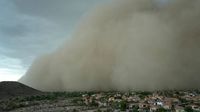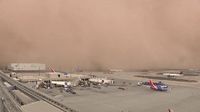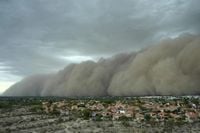On Monday, August 25, 2025, a stunning natural spectacle swept across Arizona as a massive wall of dust—known locally as a haboob—rolled through metro Phoenix, plunging the city and surrounding areas into chaos. The storm, fueled by the region’s ongoing monsoon season, brought with it not only blinding dust but also powerful winds, heavy rain, and widespread disruption to daily life, according to multiple sources including the Associated Press, CNN, and FOX Weather.
The drama began late in the afternoon as residents across Phoenix and nearby communities watched the sky darken and visibility drop to near zero. For Bernae Boykin Hitesman, who was driving her two children home from school in Arizona City, about 60 miles southeast of Phoenix, the experience was harrowing. “I couldn’t see my hand in front of my face if I put my hand outside,” she recounted to the Associated Press. Forced to pull over, she and her children waited anxiously for roughly 15 minutes as the storm battered their car. “I was nervous,” Boykin Hitesman admitted. “My kids were really, really scared, so I was trying to be brave for them.”
Haboobs are not uncommon in Arizona’s arid landscape, especially during the monsoon season. These dust storms are propelled by thunderstorm winds that scoop up loose desert soil, creating a wall of dust that can climb thousands of feet high and stretch for miles. According to CNN, “These walls can climb thousands of feet high and stretch for miles, cutting off the horizon in seconds, similar to a blizzard in winter.” The storm’s suddenness can catch even seasoned locals off guard, as visibility can drop from clear to nothing in a matter of moments.
As the haboob swept through, the National Weather Service in Phoenix issued urgent dust storm and severe thunderstorm warnings. Drivers were cautioned to “pull aside stay alive,” a message echoed by the Arizona Department of Transportation, which reported dangerously low visibility on key highways like I-10 and I-17. In Gilbert, a suburb about 22 miles southeast of Phoenix, police reported downed trees, traffic light outages, and urged residents to avoid travel until crews could clear debris from the roads. “If you must travel, please drive with caution as we are working diligently to restore lights and clear roadways,” local police advised on social media, as cited by FOX Weather.
The storm’s impact was felt most acutely in Maricopa County, which includes Phoenix and its sprawling suburbs. PowerOutage.us reported that more than 60,000 customers across Arizona lost power at the peak of the storm, with the majority of outages concentrated in Maricopa County. The storm’s ferocity was evident in the physical damage it left behind: trees were uprooted, power lines toppled, and wind gusts reached up to 70 mph at Phoenix Sky Harbor International Airport, shredding a connector bridge, according to CNN. Near East Mesa, winds were clocked at 66 mph, and in Marana, a roof was reportedly torn off a home.
Travelers at Phoenix Sky Harbor International Airport faced significant disruptions as the haboob rolled in. For about an hour, all flights were halted—neither departures nor arrivals were allowed—as a dense cloud of dust enveloped the airport. Delays of up to 30 minutes persisted late into the night as crews assessed the damage and worked to address leaks and water accumulation in passenger areas. “Crews have been identifying leaks and attempting to clean up water where it has collected in passenger areas,” explained Heather Shelbrack, the airport’s deputy aviation director for public relations, in an email statement shared by both the Associated Press and TNND. The ground stop was eventually lifted once conditions improved and safety could be assured.
Phoenix’s encounter with the haboob was just one chapter in a broader pattern of erratic weather that has characterized the 2025 monsoon season. Mark O’Malley, a meteorologist with the National Weather Service in Phoenix, described the season as “very hit and miss.” He told reporters, “Phoenix has been drier than usual during the monsoon season, while parts of southeast and north-central Arizona have had a fair amount of rain.” Indeed, despite the deluge on Monday—Phoenix recorded its second-wettest day of the year with just under a quarter inch of rain—the city is still experiencing its tenth-driest start to any year since record-keeping began in 1895, according to FOX Weather. Tucson, meanwhile, is enduring its third-driest year to date.
The monsoon’s arrival, though tardy and inconsistent, is a mixed blessing for Arizona. The state remains gripped by drought, and any rainfall is welcome relief for parched landscapes. A ridge of high pressure shifting toward the Four Corners region over the preceding weekend helped push monsoonal moisture into Arizona, setting the stage for both the haboob and the subsequent thunderstorms. The FOX Forecast Center noted that more precipitation and thunderstorms were expected in the coming days, with the National Weather Service forecasting a 40% chance of rain for Tuesday, August 26. However, this sudden influx of moisture also brings risks: NOAA’s Weather Prediction Center placed parts of southern Arizona under a Level 2 out of 4 flash flood risk, warning that rainfall rates could reach 1 to 1.5 inches per hour in some locations.
For residents like Richard Filley, a retired university professor living in Gilbert, the storm was both awe-inspiring and unsettling. “The windstorm part of it, I’m glad it’s gone,” he told the Associated Press. “You look at the photos of haboobs and they are a spectacular natural phenomenon. They are kind of beautiful in their own way.” Still, the fine dust managed to infiltrate his home, finding its way through “every little crack and space.”
Monday’s haboob wasn’t the only dust storm to grab headlines in the Southwest that week. Over the weekend, a similar event swept through Nevada’s Black Rock Desert, disrupting the annual Burning Man festival and forcing organizers and vendors to scramble for cover. Such storms are a hallmark of the Southwest’s summer monsoon, a season marked by sudden shifts from scorching heat to violent weather.
As the dust settled—literally and figuratively—across Phoenix and its suburbs, cleanup crews fanned out to restore power, clear debris, and repair damaged infrastructure. The city braced for more storms, with officials and meteorologists alike reminding residents to stay alert as the monsoon season continues to unfold. For now, the haboob of August 25 stands as a dramatic reminder of nature’s power and the unpredictability that comes with life in Arizona’s desert heartland.






